Report: Leadership, Management, and Operational Strategies at ASDA
VerifiedAdded on 2023/01/03
|10
|3106
|54
Report
AI Summary
This report examines leadership and management practices within ASDA, a British supermarket chain. It explores the roles of leaders and managers in various situations, including conflict resolution and rapid change, highlighting the application of different leadership theories such as situational, system, and contingency leadership. The report also delves into key approaches to operations management, including Six Sigma, queuing theory, Total Quality Management (TQM), and continuous improvement, and discusses their importance in achieving business goals. Finally, it analyzes factors within the business environment that influence operational management and decision-making at ASDA, providing a comprehensive overview of the company's operational strategies.
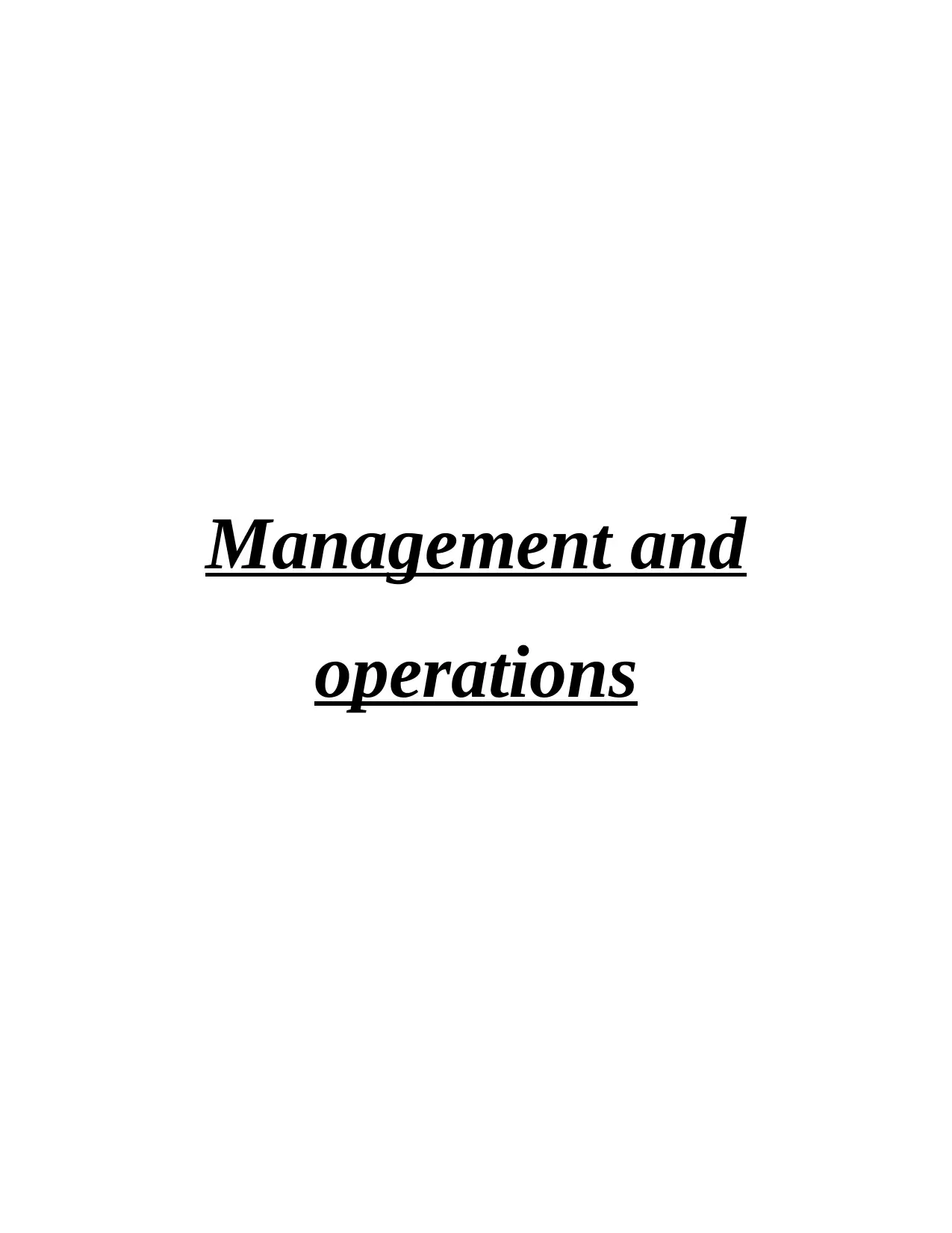
Management and
operations
operations
Paraphrase This Document
Need a fresh take? Get an instant paraphrase of this document with our AI Paraphraser
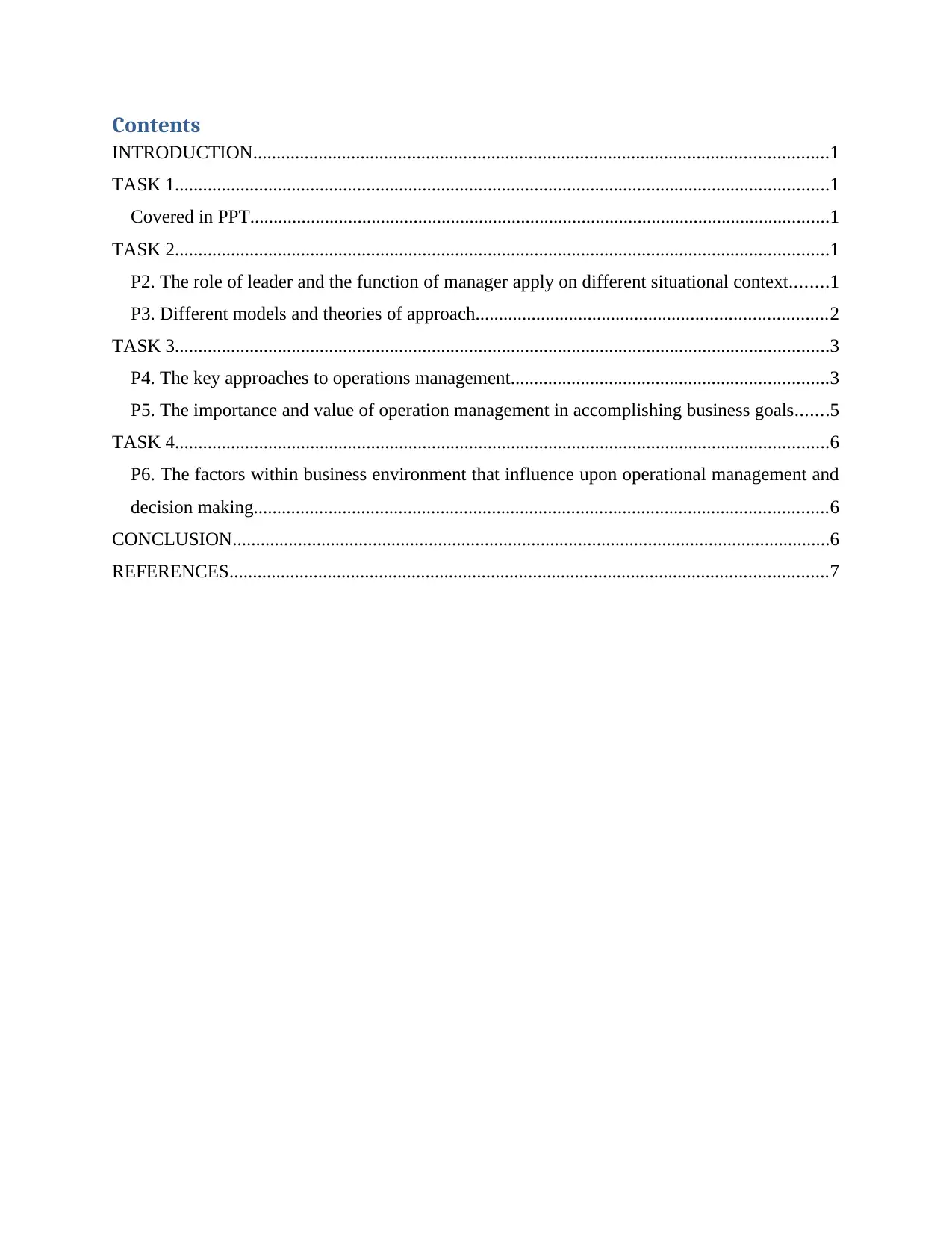
Contents
INTRODUCTION...........................................................................................................................1
TASK 1............................................................................................................................................1
Covered in PPT............................................................................................................................1
TASK 2............................................................................................................................................1
P2. The role of leader and the function of manager apply on different situational context........1
P3. Different models and theories of approach...........................................................................2
TASK 3............................................................................................................................................3
P4. The key approaches to operations management....................................................................3
P5. The importance and value of operation management in accomplishing business goals.......5
TASK 4............................................................................................................................................6
P6. The factors within business environment that influence upon operational management and
decision making...........................................................................................................................6
CONCLUSION................................................................................................................................6
REFERENCES................................................................................................................................7
INTRODUCTION...........................................................................................................................1
TASK 1............................................................................................................................................1
Covered in PPT............................................................................................................................1
TASK 2............................................................................................................................................1
P2. The role of leader and the function of manager apply on different situational context........1
P3. Different models and theories of approach...........................................................................2
TASK 3............................................................................................................................................3
P4. The key approaches to operations management....................................................................3
P5. The importance and value of operation management in accomplishing business goals.......5
TASK 4............................................................................................................................................6
P6. The factors within business environment that influence upon operational management and
decision making...........................................................................................................................6
CONCLUSION................................................................................................................................6
REFERENCES................................................................................................................................7

INTRODUCTION
Management is the activity of planning, managing, leading, controlling and conducting the
business operations and actions so that business of the company can operate in better manner.
Operation management is the management of business process to earn the highest level of
effectiveness potential in the business organisation. It is consumed with changing materials and
labour into the products and facilities as effective as potential to increase the earning of a
venture. It can be an activity of adequate administration of assets that are considered by the
enterprise in business operation such as worker, technology, equipment and many more (Bozarth
and Handfield, 2016). This written document is based o ASDA which is a British supermarket
retail sector company. This venture was incorporated in 1949 and is headquartered in West
Yorkshire, England. The written document will explain about role of leader and function of
manages in diverse situations and application of several conceptions models of approach,
Moreover, it will defined the key tools of operation management and the essentialness as well as
value of operation management in term of attaining business goals. Along with this, it will
describe about different business environment factors that impact operation management and
decision making.
TASK 1
Covered in PPT
TASK 2
P2. The role of leader and the function of manager apply on different situational context
There is some organisational situation in which leader and manger play an effective role,
the explanation of them in reference to ASDA is as under:
Conflict resolution- In ASDA, the circumstance of conflict resolution can create and
occur when company need to devise innovation in its busyness by offering mobile application to
its customers so that they can earn the advantages of the facilities and commodities of this
venture in effective manner. To make this innovation, the administration can make a group so
that workers can work in context of it. In group, the situation of conflicts can occur when
teammates will not share information and strategies across the group. So the situation of conflict
arises due to ineffective communication and creates issues within the team. In context of
1
Management is the activity of planning, managing, leading, controlling and conducting the
business operations and actions so that business of the company can operate in better manner.
Operation management is the management of business process to earn the highest level of
effectiveness potential in the business organisation. It is consumed with changing materials and
labour into the products and facilities as effective as potential to increase the earning of a
venture. It can be an activity of adequate administration of assets that are considered by the
enterprise in business operation such as worker, technology, equipment and many more (Bozarth
and Handfield, 2016). This written document is based o ASDA which is a British supermarket
retail sector company. This venture was incorporated in 1949 and is headquartered in West
Yorkshire, England. The written document will explain about role of leader and function of
manages in diverse situations and application of several conceptions models of approach,
Moreover, it will defined the key tools of operation management and the essentialness as well as
value of operation management in term of attaining business goals. Along with this, it will
describe about different business environment factors that impact operation management and
decision making.
TASK 1
Covered in PPT
TASK 2
P2. The role of leader and the function of manager apply on different situational context
There is some organisational situation in which leader and manger play an effective role,
the explanation of them in reference to ASDA is as under:
Conflict resolution- In ASDA, the circumstance of conflict resolution can create and
occur when company need to devise innovation in its busyness by offering mobile application to
its customers so that they can earn the advantages of the facilities and commodities of this
venture in effective manner. To make this innovation, the administration can make a group so
that workers can work in context of it. In group, the situation of conflicts can occur when
teammates will not share information and strategies across the group. So the situation of conflict
arises due to ineffective communication and creates issues within the team. In context of
1
⊘ This is a preview!⊘
Do you want full access?
Subscribe today to unlock all pages.

Trusted by 1+ million students worldwide
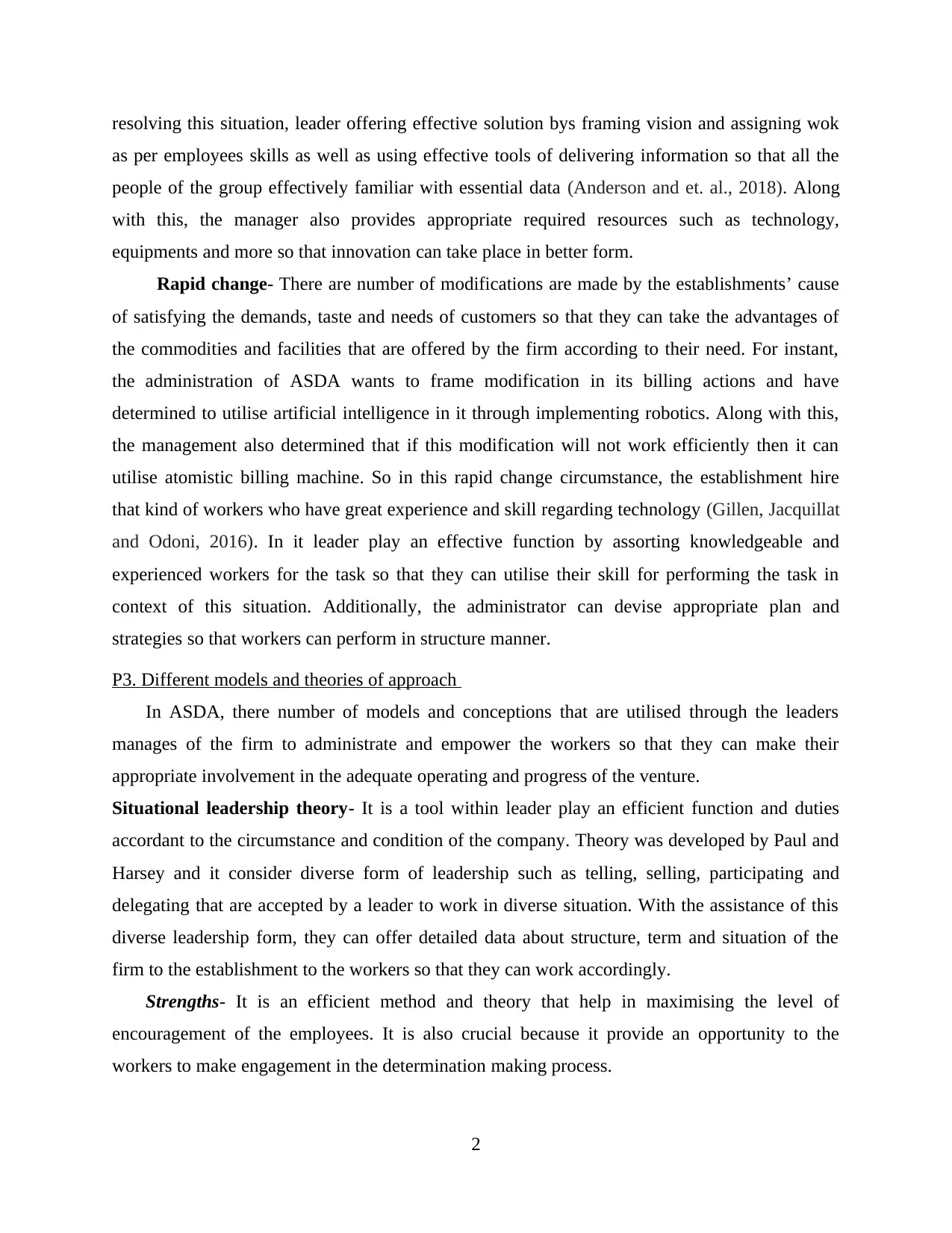
resolving this situation, leader offering effective solution bys framing vision and assigning wok
as per employees skills as well as using effective tools of delivering information so that all the
people of the group effectively familiar with essential data (Anderson and et. al., 2018). Along
with this, the manager also provides appropriate required resources such as technology,
equipments and more so that innovation can take place in better form.
Rapid change- There are number of modifications are made by the establishments’ cause
of satisfying the demands, taste and needs of customers so that they can take the advantages of
the commodities and facilities that are offered by the firm according to their need. For instant,
the administration of ASDA wants to frame modification in its billing actions and have
determined to utilise artificial intelligence in it through implementing robotics. Along with this,
the management also determined that if this modification will not work efficiently then it can
utilise atomistic billing machine. So in this rapid change circumstance, the establishment hire
that kind of workers who have great experience and skill regarding technology (Gillen, Jacquillat
and Odoni, 2016). In it leader play an effective function by assorting knowledgeable and
experienced workers for the task so that they can utilise their skill for performing the task in
context of this situation. Additionally, the administrator can devise appropriate plan and
strategies so that workers can perform in structure manner.
P3. Different models and theories of approach
In ASDA, there number of models and conceptions that are utilised through the leaders
manages of the firm to administrate and empower the workers so that they can make their
appropriate involvement in the adequate operating and progress of the venture.
Situational leadership theory- It is a tool within leader play an efficient function and duties
accordant to the circumstance and condition of the company. Theory was developed by Paul and
Harsey and it consider diverse form of leadership such as telling, selling, participating and
delegating that are accepted by a leader to work in diverse situation. With the assistance of this
diverse leadership form, they can offer detailed data about structure, term and situation of the
firm to the establishment to the workers so that they can work accordingly.
Strengths- It is an efficient method and theory that help in maximising the level of
encouragement of the employees. It is also crucial because it provide an opportunity to the
workers to make engagement in the determination making process.
2
as per employees skills as well as using effective tools of delivering information so that all the
people of the group effectively familiar with essential data (Anderson and et. al., 2018). Along
with this, the manager also provides appropriate required resources such as technology,
equipments and more so that innovation can take place in better form.
Rapid change- There are number of modifications are made by the establishments’ cause
of satisfying the demands, taste and needs of customers so that they can take the advantages of
the commodities and facilities that are offered by the firm according to their need. For instant,
the administration of ASDA wants to frame modification in its billing actions and have
determined to utilise artificial intelligence in it through implementing robotics. Along with this,
the management also determined that if this modification will not work efficiently then it can
utilise atomistic billing machine. So in this rapid change circumstance, the establishment hire
that kind of workers who have great experience and skill regarding technology (Gillen, Jacquillat
and Odoni, 2016). In it leader play an effective function by assorting knowledgeable and
experienced workers for the task so that they can utilise their skill for performing the task in
context of this situation. Additionally, the administrator can devise appropriate plan and
strategies so that workers can perform in structure manner.
P3. Different models and theories of approach
In ASDA, there number of models and conceptions that are utilised through the leaders
manages of the firm to administrate and empower the workers so that they can make their
appropriate involvement in the adequate operating and progress of the venture.
Situational leadership theory- It is a tool within leader play an efficient function and duties
accordant to the circumstance and condition of the company. Theory was developed by Paul and
Harsey and it consider diverse form of leadership such as telling, selling, participating and
delegating that are accepted by a leader to work in diverse situation. With the assistance of this
diverse leadership form, they can offer detailed data about structure, term and situation of the
firm to the establishment to the workers so that they can work accordingly.
Strengths- It is an efficient method and theory that help in maximising the level of
encouragement of the employees. It is also crucial because it provide an opportunity to the
workers to make engagement in the determination making process.
2
Paraphrase This Document
Need a fresh take? Get an instant paraphrase of this document with our AI Paraphraser
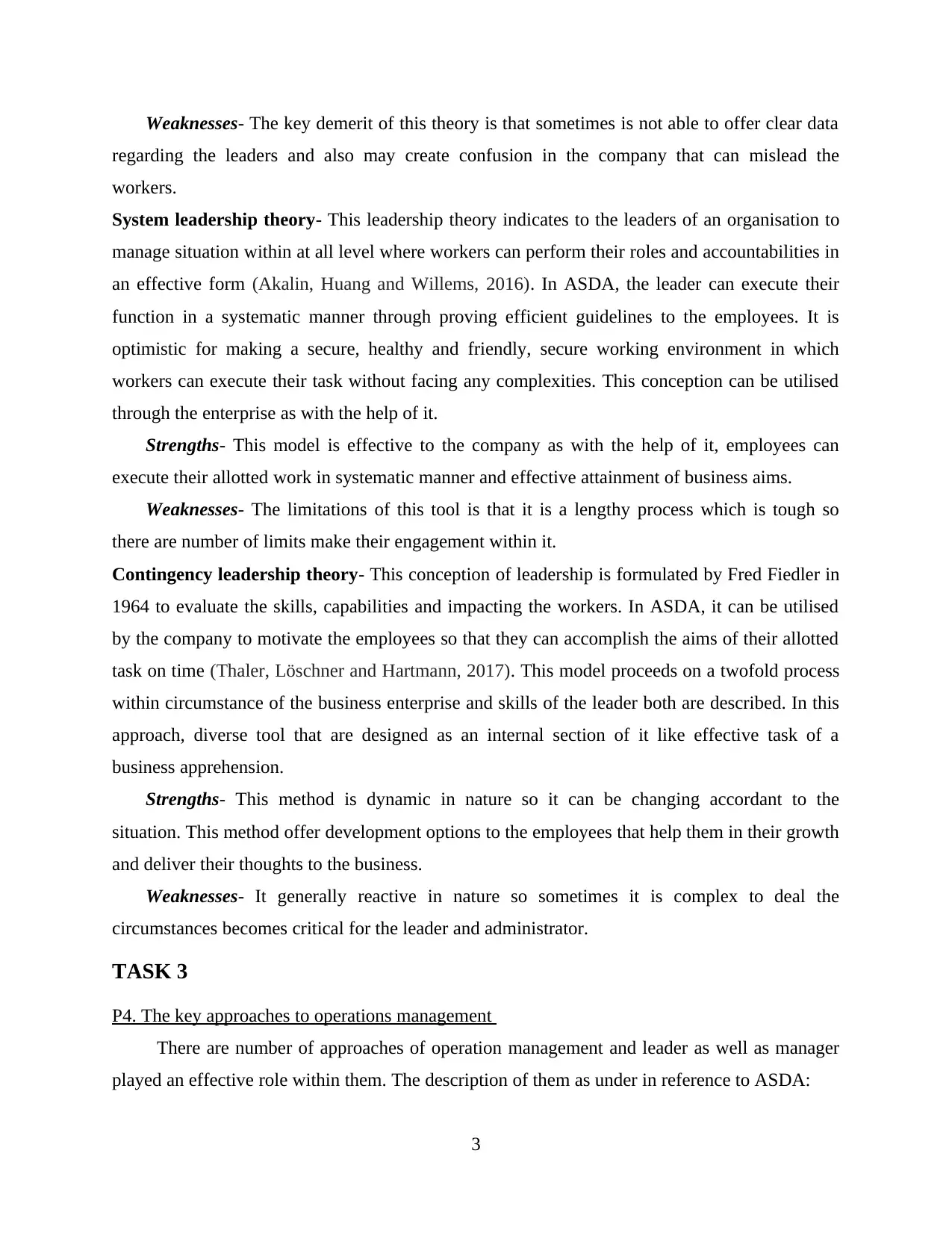
Weaknesses- The key demerit of this theory is that sometimes is not able to offer clear data
regarding the leaders and also may create confusion in the company that can mislead the
workers.
System leadership theory- This leadership theory indicates to the leaders of an organisation to
manage situation within at all level where workers can perform their roles and accountabilities in
an effective form (Akalin, Huang and Willems, 2016). In ASDA, the leader can execute their
function in a systematic manner through proving efficient guidelines to the employees. It is
optimistic for making a secure, healthy and friendly, secure working environment in which
workers can execute their task without facing any complexities. This conception can be utilised
through the enterprise as with the help of it.
Strengths- This model is effective to the company as with the help of it, employees can
execute their allotted work in systematic manner and effective attainment of business aims.
Weaknesses- The limitations of this tool is that it is a lengthy process which is tough so
there are number of limits make their engagement within it.
Contingency leadership theory- This conception of leadership is formulated by Fred Fiedler in
1964 to evaluate the skills, capabilities and impacting the workers. In ASDA, it can be utilised
by the company to motivate the employees so that they can accomplish the aims of their allotted
task on time (Thaler, Löschner and Hartmann, 2017). This model proceeds on a twofold process
within circumstance of the business enterprise and skills of the leader both are described. In this
approach, diverse tool that are designed as an internal section of it like effective task of a
business apprehension.
Strengths- This method is dynamic in nature so it can be changing accordant to the
situation. This method offer development options to the employees that help them in their growth
and deliver their thoughts to the business.
Weaknesses- It generally reactive in nature so sometimes it is complex to deal the
circumstances becomes critical for the leader and administrator.
TASK 3
P4. The key approaches to operations management
There are number of approaches of operation management and leader as well as manager
played an effective role within them. The description of them as under in reference to ASDA:
3
regarding the leaders and also may create confusion in the company that can mislead the
workers.
System leadership theory- This leadership theory indicates to the leaders of an organisation to
manage situation within at all level where workers can perform their roles and accountabilities in
an effective form (Akalin, Huang and Willems, 2016). In ASDA, the leader can execute their
function in a systematic manner through proving efficient guidelines to the employees. It is
optimistic for making a secure, healthy and friendly, secure working environment in which
workers can execute their task without facing any complexities. This conception can be utilised
through the enterprise as with the help of it.
Strengths- This model is effective to the company as with the help of it, employees can
execute their allotted work in systematic manner and effective attainment of business aims.
Weaknesses- The limitations of this tool is that it is a lengthy process which is tough so
there are number of limits make their engagement within it.
Contingency leadership theory- This conception of leadership is formulated by Fred Fiedler in
1964 to evaluate the skills, capabilities and impacting the workers. In ASDA, it can be utilised
by the company to motivate the employees so that they can accomplish the aims of their allotted
task on time (Thaler, Löschner and Hartmann, 2017). This model proceeds on a twofold process
within circumstance of the business enterprise and skills of the leader both are described. In this
approach, diverse tool that are designed as an internal section of it like effective task of a
business apprehension.
Strengths- This method is dynamic in nature so it can be changing accordant to the
situation. This method offer development options to the employees that help them in their growth
and deliver their thoughts to the business.
Weaknesses- It generally reactive in nature so sometimes it is complex to deal the
circumstances becomes critical for the leader and administrator.
TASK 3
P4. The key approaches to operations management
There are number of approaches of operation management and leader as well as manager
played an effective role within them. The description of them as under in reference to ASDA:
3
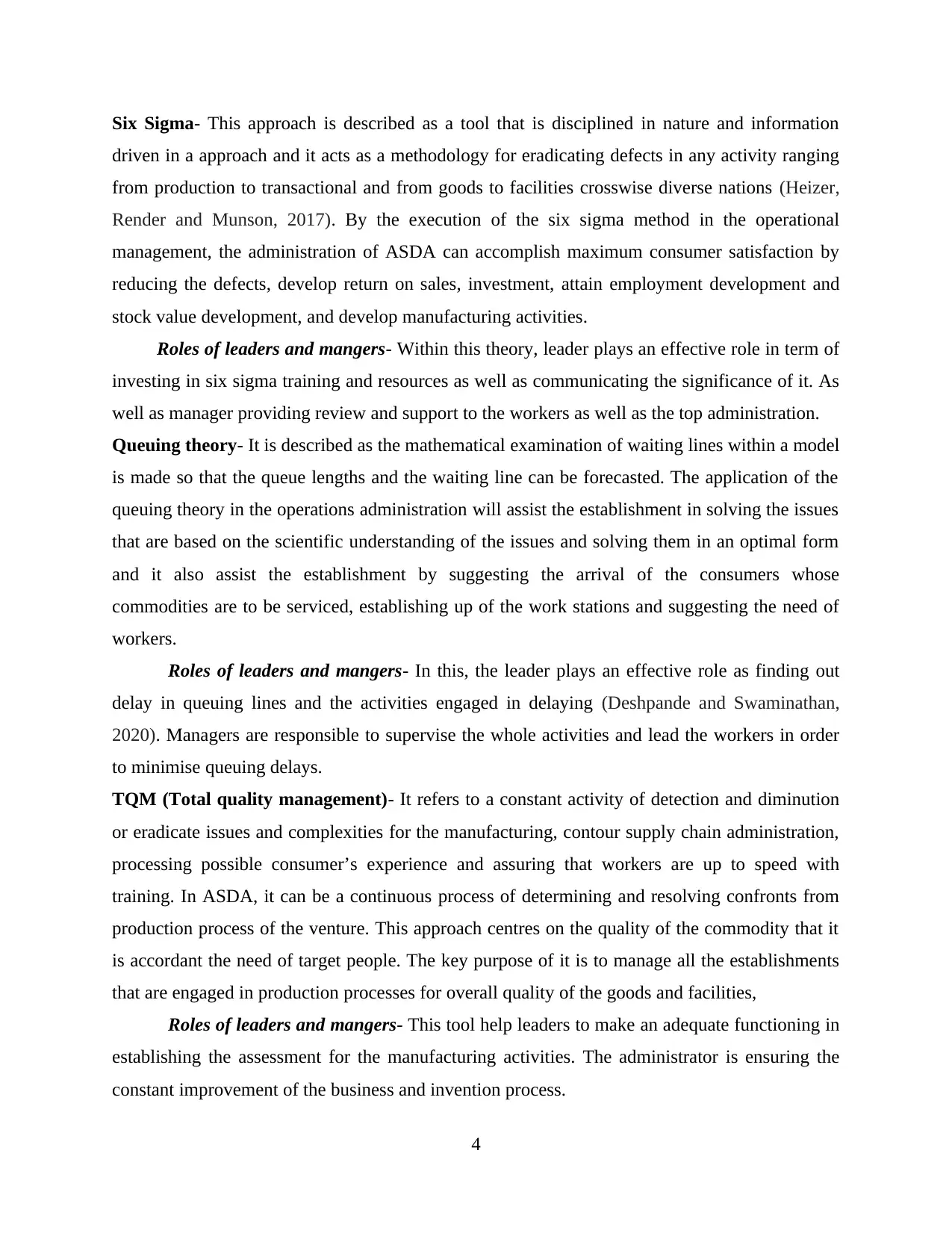
Six Sigma- This approach is described as a tool that is disciplined in nature and information
driven in a approach and it acts as a methodology for eradicating defects in any activity ranging
from production to transactional and from goods to facilities crosswise diverse nations (Heizer,
Render and Munson, 2017). By the execution of the six sigma method in the operational
management, the administration of ASDA can accomplish maximum consumer satisfaction by
reducing the defects, develop return on sales, investment, attain employment development and
stock value development, and develop manufacturing activities.
Roles of leaders and mangers- Within this theory, leader plays an effective role in term of
investing in six sigma training and resources as well as communicating the significance of it. As
well as manager providing review and support to the workers as well as the top administration.
Queuing theory- It is described as the mathematical examination of waiting lines within a model
is made so that the queue lengths and the waiting line can be forecasted. The application of the
queuing theory in the operations administration will assist the establishment in solving the issues
that are based on the scientific understanding of the issues and solving them in an optimal form
and it also assist the establishment by suggesting the arrival of the consumers whose
commodities are to be serviced, establishing up of the work stations and suggesting the need of
workers.
Roles of leaders and mangers- In this, the leader plays an effective role as finding out
delay in queuing lines and the activities engaged in delaying (Deshpande and Swaminathan,
2020). Managers are responsible to supervise the whole activities and lead the workers in order
to minimise queuing delays.
TQM (Total quality management)- It refers to a constant activity of detection and diminution
or eradicate issues and complexities for the manufacturing, contour supply chain administration,
processing possible consumer’s experience and assuring that workers are up to speed with
training. In ASDA, it can be a continuous process of determining and resolving confronts from
production process of the venture. This approach centres on the quality of the commodity that it
is accordant the need of target people. The key purpose of it is to manage all the establishments
that are engaged in production processes for overall quality of the goods and facilities,
Roles of leaders and mangers- This tool help leaders to make an adequate functioning in
establishing the assessment for the manufacturing activities. The administrator is ensuring the
constant improvement of the business and invention process.
4
driven in a approach and it acts as a methodology for eradicating defects in any activity ranging
from production to transactional and from goods to facilities crosswise diverse nations (Heizer,
Render and Munson, 2017). By the execution of the six sigma method in the operational
management, the administration of ASDA can accomplish maximum consumer satisfaction by
reducing the defects, develop return on sales, investment, attain employment development and
stock value development, and develop manufacturing activities.
Roles of leaders and mangers- Within this theory, leader plays an effective role in term of
investing in six sigma training and resources as well as communicating the significance of it. As
well as manager providing review and support to the workers as well as the top administration.
Queuing theory- It is described as the mathematical examination of waiting lines within a model
is made so that the queue lengths and the waiting line can be forecasted. The application of the
queuing theory in the operations administration will assist the establishment in solving the issues
that are based on the scientific understanding of the issues and solving them in an optimal form
and it also assist the establishment by suggesting the arrival of the consumers whose
commodities are to be serviced, establishing up of the work stations and suggesting the need of
workers.
Roles of leaders and mangers- In this, the leader plays an effective role as finding out
delay in queuing lines and the activities engaged in delaying (Deshpande and Swaminathan,
2020). Managers are responsible to supervise the whole activities and lead the workers in order
to minimise queuing delays.
TQM (Total quality management)- It refers to a constant activity of detection and diminution
or eradicate issues and complexities for the manufacturing, contour supply chain administration,
processing possible consumer’s experience and assuring that workers are up to speed with
training. In ASDA, it can be a continuous process of determining and resolving confronts from
production process of the venture. This approach centres on the quality of the commodity that it
is accordant the need of target people. The key purpose of it is to manage all the establishments
that are engaged in production processes for overall quality of the goods and facilities,
Roles of leaders and mangers- This tool help leaders to make an adequate functioning in
establishing the assessment for the manufacturing activities. The administrator is ensuring the
constant improvement of the business and invention process.
4
⊘ This is a preview!⊘
Do you want full access?
Subscribe today to unlock all pages.

Trusted by 1+ million students worldwide
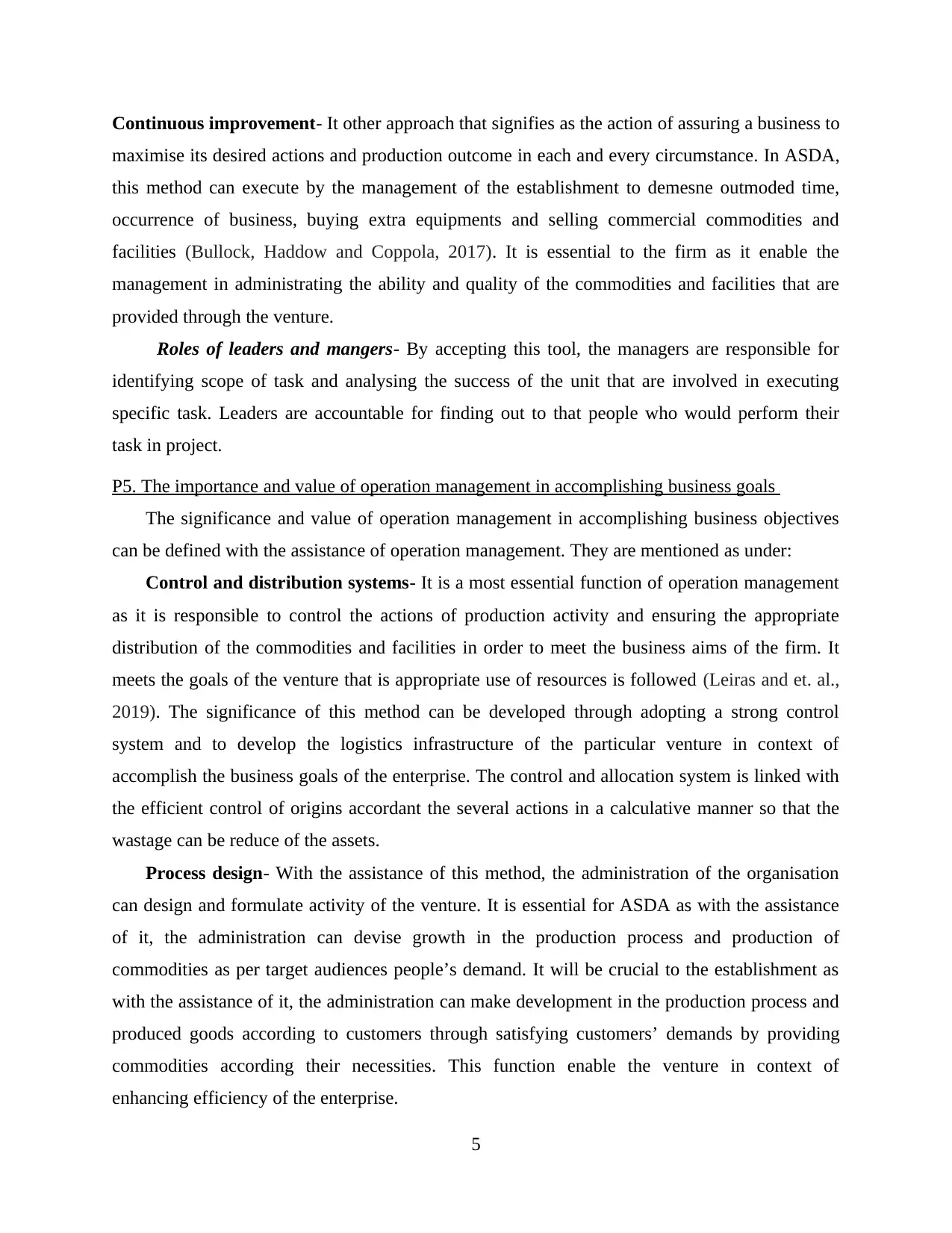
Continuous improvement- It other approach that signifies as the action of assuring a business to
maximise its desired actions and production outcome in each and every circumstance. In ASDA,
this method can execute by the management of the establishment to demesne outmoded time,
occurrence of business, buying extra equipments and selling commercial commodities and
facilities (Bullock, Haddow and Coppola, 2017). It is essential to the firm as it enable the
management in administrating the ability and quality of the commodities and facilities that are
provided through the venture.
Roles of leaders and mangers- By accepting this tool, the managers are responsible for
identifying scope of task and analysing the success of the unit that are involved in executing
specific task. Leaders are accountable for finding out to that people who would perform their
task in project.
P5. The importance and value of operation management in accomplishing business goals
The significance and value of operation management in accomplishing business objectives
can be defined with the assistance of operation management. They are mentioned as under:
Control and distribution systems- It is a most essential function of operation management
as it is responsible to control the actions of production activity and ensuring the appropriate
distribution of the commodities and facilities in order to meet the business aims of the firm. It
meets the goals of the venture that is appropriate use of resources is followed (Leiras and et. al.,
2019). The significance of this method can be developed through adopting a strong control
system and to develop the logistics infrastructure of the particular venture in context of
accomplish the business goals of the enterprise. The control and allocation system is linked with
the efficient control of origins accordant the several actions in a calculative manner so that the
wastage can be reduce of the assets.
Process design- With the assistance of this method, the administration of the organisation
can design and formulate activity of the venture. It is essential for ASDA as with the assistance
of it, the administration can devise growth in the production process and production of
commodities as per target audiences people’s demand. It will be crucial to the establishment as
with the assistance of it, the administration can make development in the production process and
produced goods according to customers through satisfying customers’ demands by providing
commodities according their necessities. This function enable the venture in context of
enhancing efficiency of the enterprise.
5
maximise its desired actions and production outcome in each and every circumstance. In ASDA,
this method can execute by the management of the establishment to demesne outmoded time,
occurrence of business, buying extra equipments and selling commercial commodities and
facilities (Bullock, Haddow and Coppola, 2017). It is essential to the firm as it enable the
management in administrating the ability and quality of the commodities and facilities that are
provided through the venture.
Roles of leaders and mangers- By accepting this tool, the managers are responsible for
identifying scope of task and analysing the success of the unit that are involved in executing
specific task. Leaders are accountable for finding out to that people who would perform their
task in project.
P5. The importance and value of operation management in accomplishing business goals
The significance and value of operation management in accomplishing business objectives
can be defined with the assistance of operation management. They are mentioned as under:
Control and distribution systems- It is a most essential function of operation management
as it is responsible to control the actions of production activity and ensuring the appropriate
distribution of the commodities and facilities in order to meet the business aims of the firm. It
meets the goals of the venture that is appropriate use of resources is followed (Leiras and et. al.,
2019). The significance of this method can be developed through adopting a strong control
system and to develop the logistics infrastructure of the particular venture in context of
accomplish the business goals of the enterprise. The control and allocation system is linked with
the efficient control of origins accordant the several actions in a calculative manner so that the
wastage can be reduce of the assets.
Process design- With the assistance of this method, the administration of the organisation
can design and formulate activity of the venture. It is essential for ASDA as with the assistance
of it, the administration can devise growth in the production process and production of
commodities as per target audiences people’s demand. It will be crucial to the establishment as
with the assistance of it, the administration can make development in the production process and
produced goods according to customers through satisfying customers’ demands by providing
commodities according their necessities. This function enable the venture in context of
enhancing efficiency of the enterprise.
5
Paraphrase This Document
Need a fresh take? Get an instant paraphrase of this document with our AI Paraphraser

TASK 4
P6. The factors within business environment that influence upon operational management and
decision making
Corporate social responsibility- It is defined a business approach that involve to the
sustainable development by delivering economic, social and ecological benefits to all its
stakeholders. In ASDA, the administration of the venture design CSR policy that are efficient top
the stakeholder and also for the social welfare (Choi, Cheng and Zhao, 2016). The firm invest it a
small portion of its revenue for the social and ecological welfare in form of organising
educational program, planting and work for the safety of the atmosphere etc. The establishment
operate its business so that the business actions did not harm the atmosphere where it is operating
its business. The management of the establishment also utilise effective quality raw material to
manufacture quality goods and also organise an efficient manufacturing that did not make
unenthusiastic influence on the atmosphere.
Sustainability- It ASDA, it is an effective aspect for the venture so that the customer can
ware about the company and the administration can attain its set business objectives in reference
to save resources that are required by the firm in upcoming time, It influence the decision
making when fluctuation arise to accomplish current and future consumer demands.
Values- It signified as an important aspect of the business as the commodities and services
are manufactured by the venture that consider value and the target people are ready to buy them
through paying any cost. In ASDA, it unfavourably influences the determination devising when
the goods are produced but not valuable (Bozarth and Handfield, 2016). When administrators
and leader focus on framing an efficient working atmosphere then workers can work
appropriately through manufacturing products goods.
CONCLUSION
It has been concluded from the defined content that operation management is a crucial
activity of administration business actions, activities and process. It is important to administrate
and manage the activities of production of goods and services. There are diverse roles that are
played through the leaders and administrators in a business firm in diverse circumstances.
Several theories and methods of leadership that are utilised by the leaders in the form to direct
6
P6. The factors within business environment that influence upon operational management and
decision making
Corporate social responsibility- It is defined a business approach that involve to the
sustainable development by delivering economic, social and ecological benefits to all its
stakeholders. In ASDA, the administration of the venture design CSR policy that are efficient top
the stakeholder and also for the social welfare (Choi, Cheng and Zhao, 2016). The firm invest it a
small portion of its revenue for the social and ecological welfare in form of organising
educational program, planting and work for the safety of the atmosphere etc. The establishment
operate its business so that the business actions did not harm the atmosphere where it is operating
its business. The management of the establishment also utilise effective quality raw material to
manufacture quality goods and also organise an efficient manufacturing that did not make
unenthusiastic influence on the atmosphere.
Sustainability- It ASDA, it is an effective aspect for the venture so that the customer can
ware about the company and the administration can attain its set business objectives in reference
to save resources that are required by the firm in upcoming time, It influence the decision
making when fluctuation arise to accomplish current and future consumer demands.
Values- It signified as an important aspect of the business as the commodities and services
are manufactured by the venture that consider value and the target people are ready to buy them
through paying any cost. In ASDA, it unfavourably influences the determination devising when
the goods are produced but not valuable (Bozarth and Handfield, 2016). When administrators
and leader focus on framing an efficient working atmosphere then workers can work
appropriately through manufacturing products goods.
CONCLUSION
It has been concluded from the defined content that operation management is a crucial
activity of administration business actions, activities and process. It is important to administrate
and manage the activities of production of goods and services. There are diverse roles that are
played through the leaders and administrators in a business firm in diverse circumstances.
Several theories and methods of leadership that are utilised by the leaders in the form to direct
6
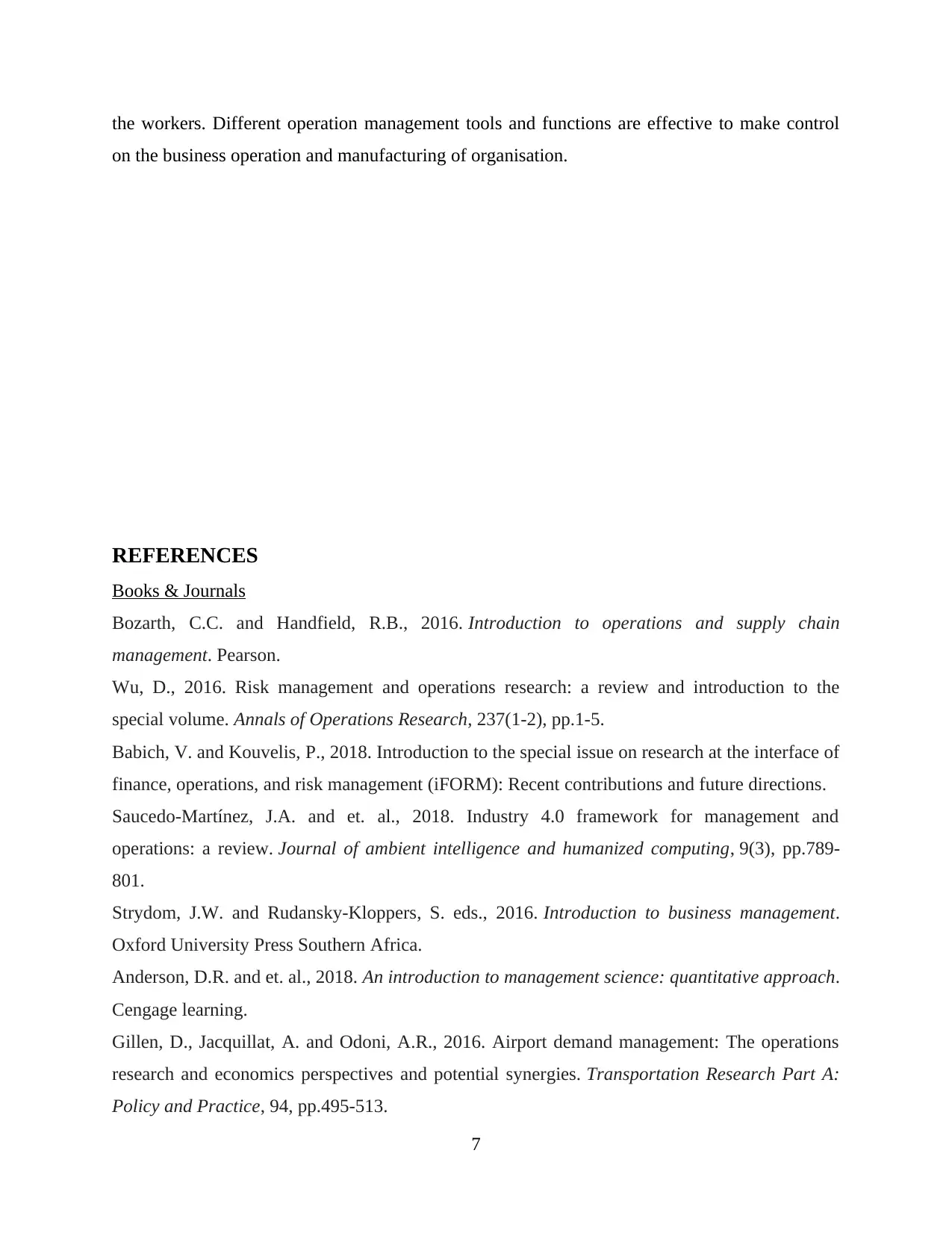
the workers. Different operation management tools and functions are effective to make control
on the business operation and manufacturing of organisation.
REFERENCES
Books & Journals
Bozarth, C.C. and Handfield, R.B., 2016. Introduction to operations and supply chain
management. Pearson.
Wu, D., 2016. Risk management and operations research: a review and introduction to the
special volume. Annals of Operations Research, 237(1-2), pp.1-5.
Babich, V. and Kouvelis, P., 2018. Introduction to the special issue on research at the interface of
finance, operations, and risk management (iFORM): Recent contributions and future directions.
Saucedo-Martínez, J.A. and et. al., 2018. Industry 4.0 framework for management and
operations: a review. Journal of ambient intelligence and humanized computing, 9(3), pp.789-
801.
Strydom, J.W. and Rudansky-Kloppers, S. eds., 2016. Introduction to business management.
Oxford University Press Southern Africa.
Anderson, D.R. and et. al., 2018. An introduction to management science: quantitative approach.
Cengage learning.
Gillen, D., Jacquillat, A. and Odoni, A.R., 2016. Airport demand management: The operations
research and economics perspectives and potential synergies. Transportation Research Part A:
Policy and Practice, 94, pp.495-513.
7
on the business operation and manufacturing of organisation.
REFERENCES
Books & Journals
Bozarth, C.C. and Handfield, R.B., 2016. Introduction to operations and supply chain
management. Pearson.
Wu, D., 2016. Risk management and operations research: a review and introduction to the
special volume. Annals of Operations Research, 237(1-2), pp.1-5.
Babich, V. and Kouvelis, P., 2018. Introduction to the special issue on research at the interface of
finance, operations, and risk management (iFORM): Recent contributions and future directions.
Saucedo-Martínez, J.A. and et. al., 2018. Industry 4.0 framework for management and
operations: a review. Journal of ambient intelligence and humanized computing, 9(3), pp.789-
801.
Strydom, J.W. and Rudansky-Kloppers, S. eds., 2016. Introduction to business management.
Oxford University Press Southern Africa.
Anderson, D.R. and et. al., 2018. An introduction to management science: quantitative approach.
Cengage learning.
Gillen, D., Jacquillat, A. and Odoni, A.R., 2016. Airport demand management: The operations
research and economics perspectives and potential synergies. Transportation Research Part A:
Policy and Practice, 94, pp.495-513.
7
⊘ This is a preview!⊘
Do you want full access?
Subscribe today to unlock all pages.

Trusted by 1+ million students worldwide
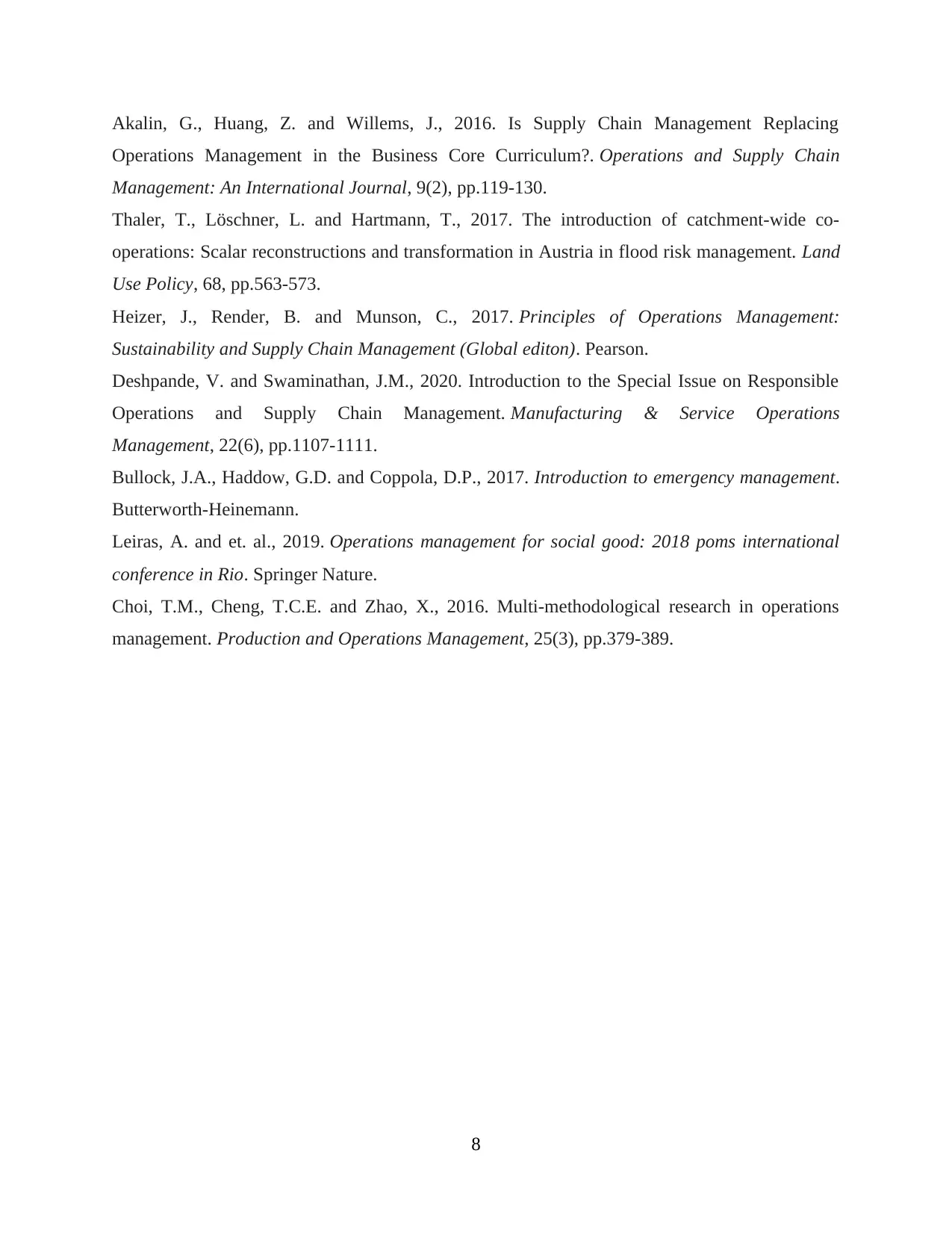
Akalin, G., Huang, Z. and Willems, J., 2016. Is Supply Chain Management Replacing
Operations Management in the Business Core Curriculum?. Operations and Supply Chain
Management: An International Journal, 9(2), pp.119-130.
Thaler, T., Löschner, L. and Hartmann, T., 2017. The introduction of catchment-wide co-
operations: Scalar reconstructions and transformation in Austria in flood risk management. Land
Use Policy, 68, pp.563-573.
Heizer, J., Render, B. and Munson, C., 2017. Principles of Operations Management:
Sustainability and Supply Chain Management (Global editon). Pearson.
Deshpande, V. and Swaminathan, J.M., 2020. Introduction to the Special Issue on Responsible
Operations and Supply Chain Management. Manufacturing & Service Operations
Management, 22(6), pp.1107-1111.
Bullock, J.A., Haddow, G.D. and Coppola, D.P., 2017. Introduction to emergency management.
Butterworth-Heinemann.
Leiras, A. and et. al., 2019. Operations management for social good: 2018 poms international
conference in Rio. Springer Nature.
Choi, T.M., Cheng, T.C.E. and Zhao, X., 2016. Multi‐methodological research in operations
management. Production and Operations Management, 25(3), pp.379-389.
8
Operations Management in the Business Core Curriculum?. Operations and Supply Chain
Management: An International Journal, 9(2), pp.119-130.
Thaler, T., Löschner, L. and Hartmann, T., 2017. The introduction of catchment-wide co-
operations: Scalar reconstructions and transformation in Austria in flood risk management. Land
Use Policy, 68, pp.563-573.
Heizer, J., Render, B. and Munson, C., 2017. Principles of Operations Management:
Sustainability and Supply Chain Management (Global editon). Pearson.
Deshpande, V. and Swaminathan, J.M., 2020. Introduction to the Special Issue on Responsible
Operations and Supply Chain Management. Manufacturing & Service Operations
Management, 22(6), pp.1107-1111.
Bullock, J.A., Haddow, G.D. and Coppola, D.P., 2017. Introduction to emergency management.
Butterworth-Heinemann.
Leiras, A. and et. al., 2019. Operations management for social good: 2018 poms international
conference in Rio. Springer Nature.
Choi, T.M., Cheng, T.C.E. and Zhao, X., 2016. Multi‐methodological research in operations
management. Production and Operations Management, 25(3), pp.379-389.
8
1 out of 10
Related Documents
Your All-in-One AI-Powered Toolkit for Academic Success.
+13062052269
info@desklib.com
Available 24*7 on WhatsApp / Email
![[object Object]](/_next/static/media/star-bottom.7253800d.svg)
Unlock your academic potential
Copyright © 2020–2025 A2Z Services. All Rights Reserved. Developed and managed by ZUCOL.





